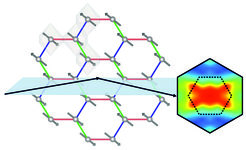Proximate ferromagnetic state in the Kitaev model material RuCl3
Resonant inelastic x-ray scattering reveals exchange interactions in a potential solid-state realization of the celebrated Kitaev model
The exactly soluble Kitaev model describes spins on a honeycomb lattice which are coupled by frustrated exchange interactions that cannot be satisfied simultaneously. Its ground state is a "spin liquid" in which quantum fluctuations obliterate magnetic order at all temperatures. Theoretical work by George Jackeli and Giniyat Khaliullin (Physical Review Letters 102, 017205 (2009)) had shown that the Kitaev model can be realized in Mott insulators with strong spin-orbit coupling, and the spin-orbit Mott insulator RuCl3 has recently emerged as a prime candidate for Kitaev physics in solids. Whereas the ground state of RuCl3 is antiferromagnetic, prior experimental work has uncovered a variety of intriguing physical properties that may indicate a spin-liquid state in magnetic fields. However, the actual spin Hamiltonian of RuCl3 has not yet been determined conclusively, so that specific theoretical predictions remain difficult.

We have used our new IRIXS spectrometer (“Intermediate-energy Resonant Inelastic X-ray Scattering”) at the PETRA-III synchrotron (H. Suzuki et al., Nature Materials 18, 563-567 (2019)) to experimentally elucidate the exchange interactions between Ru spins in RuCl3. In IRIXS, x-ray photons excite Ru core electrons into the valence-electron shell, where they generate spin excitations, thereby losing some of their energy and momentum. The momentum distribution of the re-emitted photons (see the figure) can therefore be used to obtain specific information about the spin excitations. By comparing the intensity pattern measured by IRIXS to theoretical calculations, we reconstructed the Hamiltonian that describes the Ru spin system in RuCl3. Surprisingly, the ground state of this Hamiltonian turns out to be ferromagnetic at the classical level, and the experimentally observed antiferromagnetic ground state is only stabilized by quantum zero-point fluctuations. We conclude that unconventional spin excitations associated with the metastable ferromagnetic state are key ingredients for the theoretical description of the phase behavior of RuCl3 in magnetic fields. Since IRIXS only requires crystals of characteristic dimensions ~10 μm, our approach has the potential to evolve into a powerful screening tool for the rapidly expanding list of spin-liquid candidate materials.











